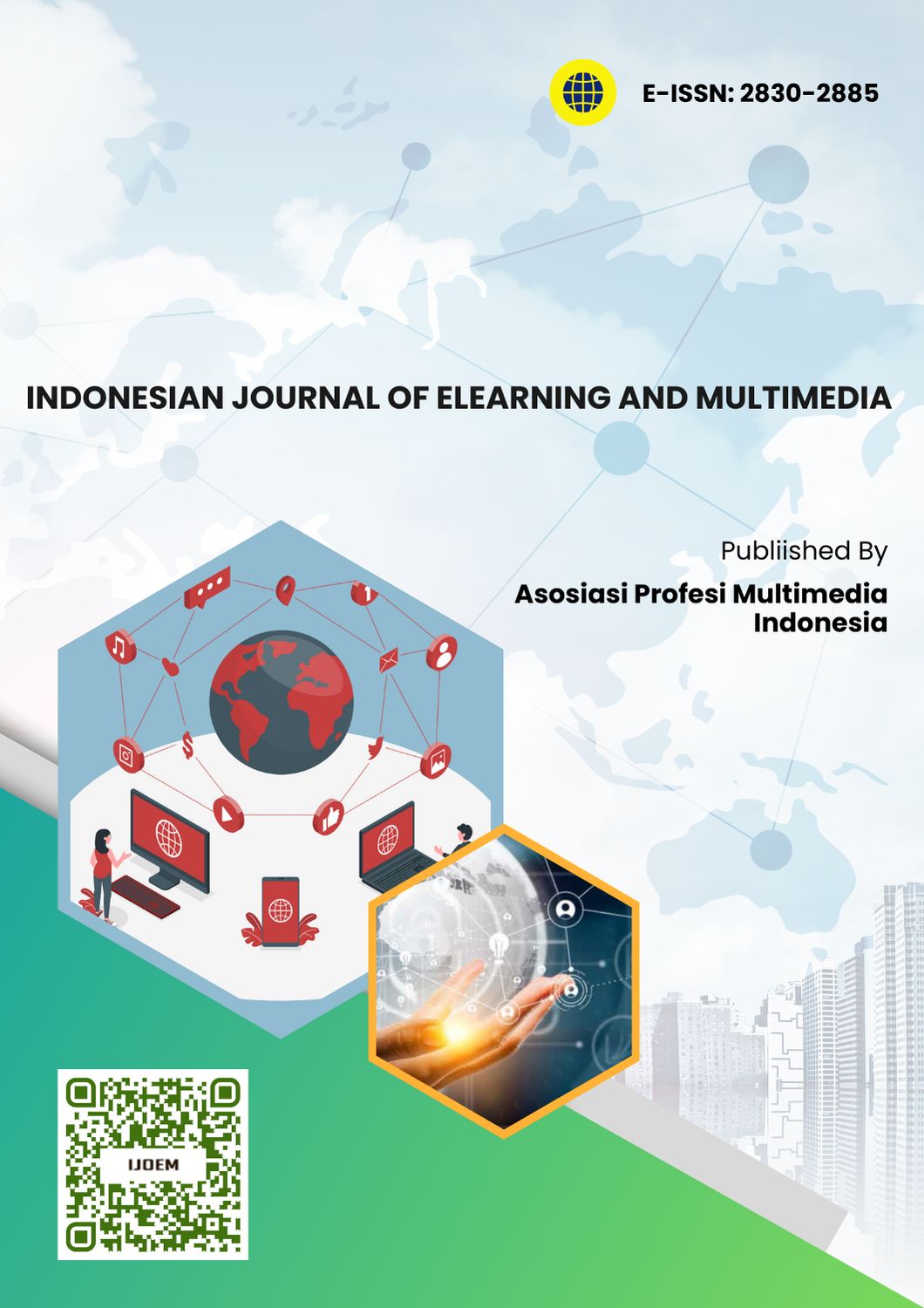Development of Learning Media Using Google Site in Qur'an Hadith Subjects at Madrasah Aliyah Negeri 1 Medan
Main Article Content
Abstract
Background: Low student motivation and poor cognitive outcomes in the Qur’an Hadith subject at MAN 1 Medan indicate the need for more interactive learning media. Traditional tools such as PowerPoint and videos are less engaging for digital-native students.
Aims: This study aims to develop a Google Sites–based digital learning medium on the topic “Competing in Goodness” tailored for eleventh-grade students to improve learning outcomes and engagement.
Methods: The study employed the ADDIE development model (Analysis, Design, Development, Implementation, Evaluation) with 35 students and 3 teachers as participants. Data were gathered through questionnaires, expert validation sheets, and post-tests.
Result: The needs analysis showed high student interest in digital media (94%) and strong teacher support (92%). Expert validation indicated high feasibility (91–93%). Trial tests demonstrated increased practicality (up to 94%) and improved post-test scores in the experimental group (82.9) versus the control group (77.0).
Conclusion: Google Sites based learning media is valid, practical, and effective for enhancing motivation and cognitive outcomes in Qur’an Hadith education at the senior high school level.
Downloads
Article Details
Copyright (c) 2025 Rika Lasmini Ritonga, Abdul Hamid K., Dewi Endriani, Dewi Endriani

This work is licensed under a Creative Commons Attribution-ShareAlike 4.0 International License.
References
Al-Fraihat, D., Joy, M., & Sinclair, J. (2020). Evaluating E-learning systems success: An empirical study. Computers in Human Behavior. Computers in human behavior, 102, 67–86. https://doi.org/10.1016/j.chb.2019.08.004
Barkati, A., & Cahyadi, A. (2024). Teknologi Sebagai Pendekatan Dalam Optimalisasi Pendidikan Agama Islam (PAI). Jurnal Pendidikan Agama Islam, 3(1), 173-181. https://doi.org/10.52434/jpai.v3i1.3739
Boer, M., Stevens, G. W., Finkenauer, C., Koning, I. M., & van den Eijnden, R. J. (2022). Validation of the Social Media Disorder Scale in Adolescents: Findings From a Large-Scale Nationally Representative Sample. Assessment, 29(8), 1658–1675. https://doi.org/10.1177/10731911211027232
Boyd, A. T., Rocconi, L. M., & Morrow, J. A. (2024). Construct validation and measurement invariance of the Parasocial Relationships in Social Media survey. PLOS ONE,. 19(3), e03. https://doi.org/10.1371/journal.pone.0300356
Dixson, M. D. (2015). Measuring student engagement in the online course: The Online Student Engagement Scale (OSE). Online Learning, 19(4), 1–15. https://doi.org/10.24059/olj.v19i4.561
Duradoni, M., Meacci, S., Panerai, G., Salvatori, G., & Guazzini, A. (2022). Development and validation of the Social Media Capital Scale (SMC): A Brand New Measure for Online Social Capital. Human Behavior and Emerging Technologies, 9903615. https://doi.org/10.1155/2022/9903615
Dwiyogo, W. D. (2018). Pembelajaran Berbasis Blended Learning. Raja Grafindo. Google Scholar
Hidayatullah, S. (2023). Pengembangan Media Pembelajaran Akidah Akhlak Berbasis Google Sites dalam Menumbuhkan Kemampuan Berpikir Kritis (Critical Thinking Skills) Siswa Kelas VII MTs Darul Aman Mataram. Nucl. Phys., 13(1), 104–116. https://doi.org/10.24036/pakar.v21i2.351
Hobbs, R., Moen, M., Tang, R., & Steager, P. (2022). Measuring the implementation of media literacy statewide: A validation study. Educational Media International. 59(3), 189. https://doi.org/10.1080/09523987.2022.2136083
Lestari, Y., & Safitri, S. (2023). Development of Google Sites Website-Based Learning Media for Local History Material in Class XI SMA N 1 Tanjung Raja. Jurnal Teknologi Pendidikan : Jurnal Penelitian Dan Pengembangan Pembelajaran, 8(3), 548. https://doi.org/10.33394/jtp.v8i3.7519
Maharani, N. S., Karim, S., Liliawati, W., & Sandion, A. (2024). Development of website media based on google sites to improve students’ conceptual understanding on dynamic fluid materials. Mimbar Pendidikan, 9(2), 72-86. https://doi.org/10.17509/mimbardik.v9i2
Majid, T. (2024). Efektivitas Penggunaan Google Sites Dalam Meningkatkan Hasil Belajar Pendidikan Agama Islam Di Kelas XI SMAN 6 Barru (Doctoral dissertation, IAIN Parepare). Google Scholar
Munawaroh, A. M., & Indah, N. K. (2022). Pengembangan Media Pembelajaran Berbasis Situs Web untuk Meningkatkan Motivasi Belajar pada Materi Struktur dan Fungsi Jaringan Tumbuhan. Berkala Ilmiah Pendidikan Biologi (BioEdu), 11(3), 579–588. https://doi.org/10.26740/bioedu.v11n3.p579-588
Ningsih, R., & Haryanto. (2025). The Effect of Google Sites Web-Based Learning Media on Students’ Science Learning Outcomes. Jurnal Penelitian Pendidikan IPA, 11(3), 539–544. https://doi.org/10.29303/jppipa.v11i3.10486
Nurdyansayah. (2019). Media Pembelajaran Inovatif. Usmida Press. Google Scholar
Nurliswati, R., & Nurlizawati, N. (2022). Penerapan Media Pembelajaran Berbasis Google Site dalam Upaya Peningkatan Hasil Belajar pada Mata Pelajaran Sosiologi di Kelas XI IPS 2 SMA Negeri 1 Ampek Angkek. Naradidik: Journal of Education and Pedagogy, 1(4), 420–429. https://doi.org/10.24036/nara.v1i4.85
Pangrazio, L., Godhe, A. L., & Ledesma, A. G. L. (2020). What is digital literacy? A comparative review of publications across three language contexts. E-Learning and Digital Media, 17(6), 442–459. https://doi.org/10.1177/2042753020946291
Pérez-Rosas, V., Kleinberg, B., Lefevre, A., & Mihalcea, R. (2018). Automatic detection of fake news. COLING 2018 - 27th International Conference on Computational Linguistics, Proceedings, 3391–3401. https://doi.org/10.48550/arxiv.1708.07104
Saguni, F. (2019). Pengaruh Metode Pembelajaran terhadap Hasil Belajar. Kanwa Publisher. Google Scholar
Said, A. R., Iriansyah, H. S., & Huzaefah, O. (2023). Pengembangan Media Pembelajaran Multimedia Interaktif Berbasis WEB Google Sites Untuk Meningkatkan Motivasi Belajar Siswa SMPN I Teluknaga Tangerang. Jurnal Citizenship Virtues, 3(2), 544–558. https://doi.org/10.37640/jcv.v3i2.1872
Sahduari, S., Saidah, F., & Azis, A. (2024). Pengembangan Media Interaktif Berbasis Google Site Pelajaran Qur’an Hadits Kelas X Di MAN Kota Palangka Raya. JP2N: Jurnal Pengembangan Dan Pengabdian Nusantara, 2 (1), 55–65. https://doi.org/10.62180/ks0ykk05
Shafiq, S., Nasreen, S., & Baig, M. S. Y. (2024). Development and validation of the social media interaction scale for youth. Pakistan Journal of Humanities and Social Sciences. 12(4), 3394-3403. https://doi.org/10.52131/pjhss.2024.v12i4.2619
Shernoff, E. S., Von Schalscha, K., Gabbard, J. L., Delmarre, A., Frazier, S. L., Buche, C., & Lisetti, C. (2020). Evaluating the usability and instructional design quality of Interactive Virtual Training for Teachers (IVT-T). Educational Technology Research and Development, 68(6), 3235-3262. https://doi.org/10.1007/s11423-020-09819-9
Wulandari, S., & Zuhroh, N. (2023). Pengembangan Media Pembelajaran Interaktif Berbasis Website Google Sites Dalam Meningkatkan Hasil Belajar. Dinamika Sosial: Jurnal Pendidikan Ilmu Pengetahuan Sosial, 2(1), 87–101. https://doi.org/10.18860/dsjpips.v2i1.2131
Yusoff, M. S. B. (2019). ABC of Content Validation and Content Validity Index Calculation. Education in Medicine Journal, 11(2), 49–54. https://doi.org/10.1016/j.chb.2019.08.004



 Rika Lasmini Ritonga
Rika Lasmini Ritonga
